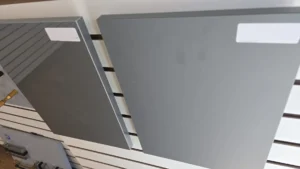Oriented Strand Board (OSB) has become a popular choice in the construction industry, offering a cost-effective and versatile alternative to traditional plywood. This engineered wood product is widely used in various aspects of house construction, providing strength, durability, and structural integrity. In this article, we’ll explore the characteristics, advantages, and applications of OSB boards in modern house construction.
What is the OSB Board?
Oriented Strand Board (OSB) is a type of engineered wood panel made by compressing and binding together strands or flakes of wood. The strands are arranged in layers at right angles to each other and then bonded with a waterproof resin. The result is a robust and dimensionally stable panel that exhibits excellent structural properties.
Advantages of OSB Board in House Construction:
- Cost-Effectiveness: One of the primary advantages of OSB is its cost-effectiveness compared to traditional plywood. Builders can achieve the same structural strength at a lower cost, making it an attractive option for various construction projects.
- Structural Strength: OSB boards have excellent structural strength and dimensional stability. They provide a solid base for sheathing, subflooring, and roofing applications, contributing to the overall stability of the structure.
- Consistent Quality: Unlike natural wood, OSB boards have consistent quality throughout the panel. This consistency reduces the likelihood of weak spots or defects, ensuring a reliable construction material.
- Large Panel Sizes: OSB boards are available in large panel sizes, reducing the number of seams and joints in construction. This feature not only simplifies the installation process but also enhances the structural integrity of the building.
- Moisture Resistance: OSB is engineered to be more resistant to moisture than traditional plywood. This makes it suitable for use in areas of the house that may be exposed to occasional dampness, such as subflooring.
- Versatility in Applications: OSB is a versatile material that can be used for various applications in house construction, including wall sheathing, roof decking, subflooring, and even as a structural panel in some instances.
Applications of OSB Board in House Construction:
- Sheathing: OSB is commonly used as sheathing for exterior walls. Its structural strength and moisture resistance make it an excellent choice for providing a sturdy and weather-resistant exterior envelope.
- Subflooring: OSB is widely used as a subfloor material. Its large panel sizes and consistent quality ensure a smooth and solid surface for the installation of finished flooring materials.
- Roof Decking: OSB panels are often used as roof decking material. They provide a strong and stable base for roofing materials, contributing to the overall integrity of the roof structure.
- Prefab Construction: OSB is frequently utilized in prefabricated construction methods. Its consistent quality and cost-effectiveness make it an ideal choice for manufacturing panels and components off-site, leading to faster and more efficient construction.
Oriented Strand Board (OSB) has become a staple in modern house construction, offering builders a cost-effective, versatile, and structurally sound material. Whether used for sheathing, subflooring, or roof decking, OSB’s consistent quality and moisture resistance make it a reliable choice in a variety of applications. As the construction industry continues to evolve, OSB remains a key player in meeting the demands of efficient, durable, and cost-conscious building practices.
Related blogs

An Analysis of the Advantages and Disadvantages of Different Edge Treatment Methods for Melamine Plywood
Melamine plywood, a material widely used in furniture manufacturing, interior decoration, and other fields, has

Additives Used in Plywood Glue: Functions and Benefits
Additives are essential in plywood glue formulations, enhancing the performance, durability, and environmental friendliness of

Synchro Plywood: A High-Quality Composite for Realistic Wood Finishes
What is Synchro Plywood? Synchro Plywood is an innovative composite material designed to emulate the

The 5 Best Kitchen Cabinet Materials: Pros and Cons
Choosing the right material for your kitchen cabinets is essential for both style and durability.
